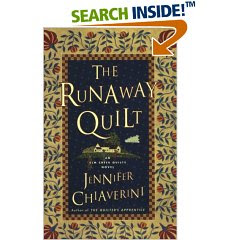
I fought with myself on whether I liked this book or not. I really did not like the main character of the memoir--Gerda, Sylvia's Great Aunt. She was pompous and self-righteous and seemed motivated to do the right thing for all the wrong reasons, but somehow she grew on me and by the end I liked her despite her flaws.
This was a tough book to read considering how all of the other "Quilter's Apprentice" series books have been really feel-good books that help you see how quilting has formed relationships between women that span generations. I was at a point in my life where I needed that "easy read" and The Runaway Quilt did not provide me with that. However, by the time I finished and was keenly aware of the fact that I missed all that wonderful female bonding that happens between quilters, I realized that I was getting just that, but it was between generations of quilters that would never know one another. It was at this point that I learned to like the book.
The Runaway Quilt posits quilts' roles in the underground railroad of the 1850s. Were they really signals for runaway slaves, and if so, how did they work? Despite evidence to the contrary, did the log cabin quilt really signal a safe haven? Most importantly for this story, was how did an Elm Creek quilt make it to South Carolina with such glaring evidence that it originated there, but no evidence that there were familial or other contacts in that area? That mystery gets solved in Gerda's memoir and through other revelations, which do make the book a worthwhile read.
Don't pick up The Runaway Quilt if you expect another "easy" read by Chiaverini. However, if you're looking for a book that helps us understand the challenges facing people during the Fugitive Slave law time period, then this book will help you see those in addition to positing how women's work (i.e. quilts) helped fuel a rebellion movement.
No comments:
Post a Comment